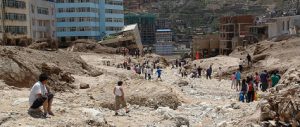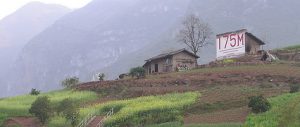On December 7, a hugely ambitious resettlement project planned for Shaanxi province in north China secured approval in principle from the standing committee of the regional government. The scale of the plans is unprecedented, far outstripping the relocation of 1.5 million people to make way for the Three Gorges Dam project.
Draft proposals from November, seen by Southern Weekend, outline plans to move 2.4 million people from 28 counties in the municipalities of Hanzhong, Ankang and Shangluo between 2011 and 2020. The figure represents more than one quarter of the total population of these cities. Around 100 million square metres of buildings would be constructed to accommodate the relocated communities and the project cost would exceed 110 billion yuan (US$16.7 billion).
If it goes ahead as planned, this could end up being the largest resettlement project in China since 1949. But unlike past relocation programmes, carried out to make way for major infrastructure schemes, this one is an attempt to reach a compromise with nature.
Last year, extremely heavy rains in southern Shaanxi triggered a series of disastrous landslides. As acting governor Zhao Zhengyong said at the meeting to approve the government’s plan, in one case “Twenty people from a single village were buried in seconds. It was utterly heartbreaking.”
He was referring to the village of Qiyan, in Ankang. On the night of July 18, Qiyan was hit by a landslide that killed 12 people and left 17 more missing. The Lin family courtyard, a 200-year old building and home of nine generations, was buried under 40 metres of mud and stone.
To prevent another such tragedy, the relocation plan promises that the locations of new homes will have safe geological and hydrological conditions. It also commits to provide land for development and farming, good transportation and basic infrastructure such as power and water.
And, to encourage the 2.4 million villagers to leave willingly, the plan sets out a vision of an appealing new life: “The relocation will mean that every administrative village will have a clinic, while educational facilities will be provided for children of compulsory school age. We will aim to provide employment or technical training for at least one member of every household and every relocation area will have television and telephone connections.”
For southern Shaanxi, this would not just be a move from danger to safety, but a leap from poverty to a more comfortable life.
The adoption of such an ambitious plan has been forced by years of frequent geological disasters that have left villagers dead and their homes destroyed. There were more than 1,000 geological disasters in Shaanxi in 2010 – 10 times as many as the previous year, and the province’s south is deemed to be most at risk.
Three days after the disaster at Ankang, acting governor Zhao stood on the rubble and spoke in public for the first time about relocating those living on mountainsides threatened by landslides.
The part of the village hit by the landslide had been considered to be the safest spot by the locals. All of the village’s 24 buildings were located at the mouth of a valley, between two mountains, where the land was flattest.
But this careful planning did not prevent the village from suffering its worst landslide in 200 years. When asked about the response, Wang Fuxiang, deputy director of Ankang’s Bureau of Land Resources, with responsibility for geological disasters, can only sigh: there is really nothing he can do. Professor Zhao Fasuo, head of both the Institute of Geology at Chang’an University and the provincial disaster response team, found that 80% of the points affected by the Ankang landslide were outside of areas marked out for protection, let alone monitoring.
After July 18, Ankang doubled the number of locations with disaster prevention plans, to over 4,000. But this figure is still seen as conservative and Zhao is blunt – most of those examined were counties or villages where problems arose over the summer. Unaffected places simply weren’t looked at. Even the experts aren’t sure how many spots are actually at risk.
Wang Fuxiang believes Ankang was lucky to have avoided a disaster on the scale of the mudslide at Zhouqu, in Gansu province, which killed more than 1,200 people in August. “Look at the Ningshan or Ziyang county towns – they could be completely wiped out if we had a really bad downpour one year. It would be Zhouqu all over again.”
Wang knows what needs to be done – but is also aware that it’s a pipe dream: “If the conditions were right, we would do a full, professional survey of potential geological disaster points, but we just haven’t got the money or the technology.”
Between 2000 and 2002, responsibility for geological disasters shifted from the water authorities to the land authorities, and state funds were made available for what is still the only risk assessment ever to be carried out in Ankang. But this “assessment” only involved sending experts to locations that local officials had reported as hazards. “The technology used was very poor, and it mainly looked at the locations the water authorities already knew about and had historical records for.”
After the 2008 Wenchuan earthquake, which displaced five million people in eight provinces including Shaanxi, Ankang invited geologists to examine more than 50 locations where significant geological changes had been noticed. Five or six obvious risk points were identified simply by looking at them – but there was no way to judge how many hazards were concealed from view.
The Land Bureau in Ankang city’s Hanbin district does not have a single geologist on its staff. In the entire city, there are only three. “We can’t claim to have any expertise worthy of the name,” admits Wang Fuxiang. If something goes wrong the team just has to respond as best as it can.
So, in the end, mass relocation has been deemed the only way to protect people. Zhao Fasuo believes the decision was helped along by the increased tendency for central government to blame local authorities for disasters recent years. Improved government finances, both at provincial and national level, have also made the resettlement project financially feasible.
But, as Zhao points out, the resettlement plan faces a vexing question: is anywhere in southern Shaanxi actually safe enough to settle millions of people?
One entire half of southern Shaanxi is prone to geological disasters. Experts describe the area as having a very weak geological environment, with locations at risk of landslides densely spread over a wide area. These disasters happen often, and cause huge damage. Where can enough safe land be found?
Take the urban district and nine counties of Ankang as an example. Only the main city and the county towns of Pingli and Hanyang have much flat land. “There is little even ground and virtually no room for city building on any scale,” says Wang Fuxiang, pointing out that the other seven county towns, which are built on slopes or gullies, “are not just unsafe – they’re extremely unsafe”.
And even if the city of Ankang is protected from geological disasters, it is still at huge risk from flooding. In 1983, a flood here killed more than 900 people, shocking both China and the world. Today, the locals say inundations happen every three years.
Zhao Fasuo is worried that the mass relocation will hit the same problems experienced by Hanzhong’s Ningqiang county, when it resettled communities badly hit by the Wenchuan earthquake. In the end, they were moved to a river course. Even then, there was little space, and a hill had to be levelled. “They did an evaluation and it was only a little safer than the original location. You couldn’t call it completely safe,” says Zhao. “The county government didn’t like it, but it was the only place they were able to find.”
Wang Fuxiang adds: “At best, we’re moving from somewhere that will see a disaster every 10 years to somewhere that will see one every two or three decades.”
Meng Dengke is a reporter at Southern Weekend and winner of the “investigative journalism” category at the 2010 Environmental Press Awards, jointly organised by chinadialogue and The Guardian.
Homepage image from Edd Jhong shows Zhouqu after the landslide.


